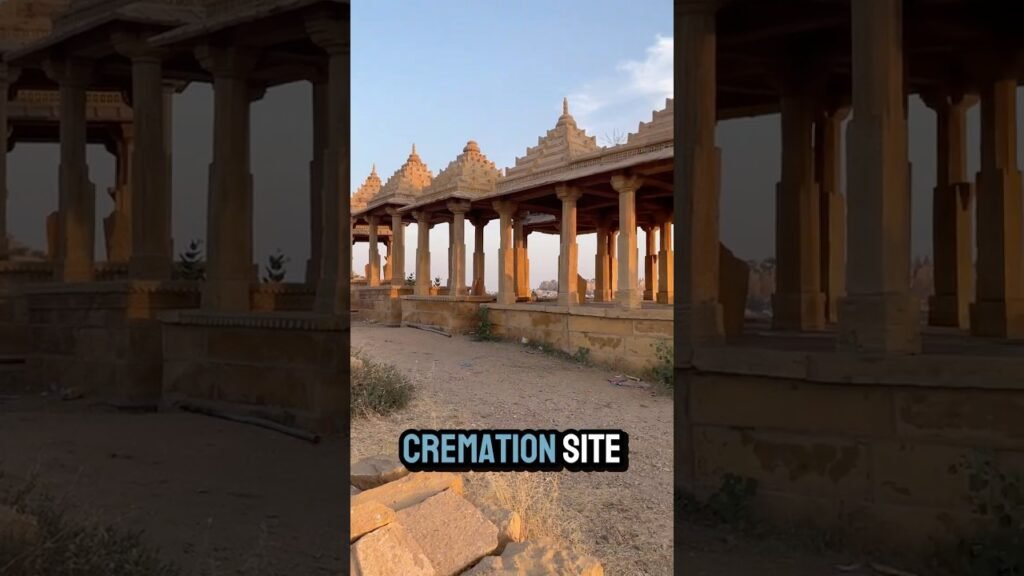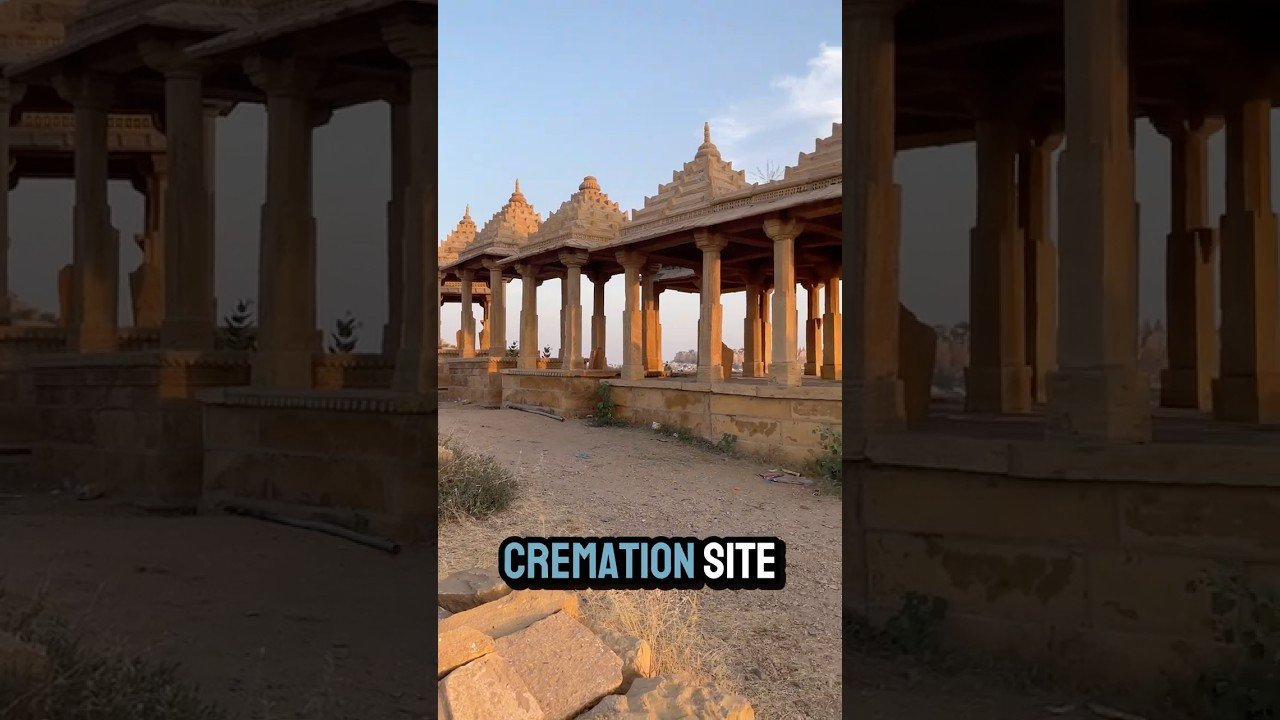Nestled just outside the enchanting city of Jaisalmer in North India lies a sacred cemetery that offers a breathtaking view of the sunset. This serene spot, known for its stunning evening vistas, also serves a deeper, spiritual purpose. As you approach, you’ll notice the delicate tendrils of smoke from recent cremations, a reminder of the cycle of life and the path to the final destination. The air is filled with both the awe of nature’s beauty and the reverence for those who have journeyed beyond.
In the gentle hues of sunset, you find a moment to pause and reflect on life’s transient nature. Paying your respects to those laid to rest here, you’re enveloped by a sense of peace and connection to something larger than yourself. This unique location is not just a spectacle of art in the sky but a grounding place where you can honor the past while appreciating the present. Feel the blend of serenity and spirituality at this extraordinary destination.
The Allure of Jaisalmer
Ah, Jaisalmer. Nestled in the heart of the Thar Desert, this golden city whispers tales of bygone eras and beckons you with its timeless charm. Picture yourself wandering through its sun-kissed, honey-hued streets, where history stands tall in grand sandstone architecture.
Historical Significance of Jaisalmer
You find yourself stepping into a living museum when you visit Jaisalmer. It’s a city whose history is woven with tales of valor and royalty, where every stone resonates with echoes of fortresses and palaces that once housed noble warriors and kings. Established in the 12th century, the city is named after Maharawal Jaisal Singh, a local king whose vision transformed this desert region into a marvel of architecture and strategic grandeur.
Geographical Location and Climate
Imagine the city shimmering like a mirage on the edge of the vast Thar Desert in Rajasthan, North India. The climate is predominantly arid, with scorching summers that cool to pleasant winters. The temperatures drop as the sun sets, making it the perfect time to reflect and watch the desert glow under the fading sunlight.
Cultural Heritage and Traditions
As you stroll through the streets, you’ll be greeted with the vibrant culture that permeates Jaisalmer. It is a city teeming with traditions, from the soulful strains of Rajasthani music to the swirling colors of folk dances. Festivals here are a riot of colors, with locals donning intricate costumes and filling the air with the aroma of traditional foods, reminding you of the deep cultural lineage the city cherishes.
A Sacred Cemetery: An Overview
Beyond the bustling life of Jaisalmer lies a quieter landscape that invites introspection—a sacred cemetery, serene and solemn. As you approach, you sense its deep-rooted spiritual significance, surrounded by a desert timelessness that both humbles and mesmerizes.
History and Background of the Cemetery
The sacred cemetery holds centuries of history, a testament to the city’s spiritual continuity. The grounds have witnessed countless cremations, where ashes have mingled with the earth, and souls have journeyed beyond the mortal realm. Walking through, you may not know who rests here, but the sense of shared reverence and continuity touches your heart.
Significance to Local Communities
To the local community, the cemetery is a place of respect and remembrance. It’s a sacred space integral to their religious traditions and practices, a tangible connection to ancestors and heritage. The cemetery is still in use today, a constant reminder of life’s cycles and the reverence with which they approach the end of earthly life.
Current Usage and Practices
The cemetery isn’t merely a relic; it thrives with current practices. You might find smoldering ashes, telling of a recent farewell. The rituals performed here are solemn, yet filled with a sense of peace, intertwining personal loss with the assurance of spiritual journeying. Respect for those who have crossed to the other side permeates the air, a silent invitation for you to reflect on the mystery of life and death.
Sunset: A Time for Reflection
In Jaisalmer, sunsets are more than just transitions from day to night—they are moments that invite you to pause, reflect, and connect with the universe against a backdrop painted in hues of orange and gold.
The Beauty of Sunsets in Desert Landscapes
Imagine standing amidst endless sands as the sun begins to set—casting long, gentle shadows and splashing the horizon with colors that artists strive to capture. The beauty is surreal, as if the desert itself sighs in contentment, finally cooling off after a long day under the harsh sun.
Symbolism of Sunsets in Culture
Sunsets carry rich symbolism in many cultures, representing endings, transitions, and the promise of renewal. As you watch the sun dip below the horizon, you might find yourself contemplating the day’s end as a metaphor for life’s inevitable cycles, a reminder of the transient nature of time.
Personal Reflections and Experiences
Here, as you watch the sunset, personal reflections bubble up like water in the desert. The simplicity of the moment invites you to let go of worldly concerns, finding peace in the vastness around and inside you. It’s a time to breathe, to feel life’s pulse, and to find beauty in both its chaos and its calm.

This image is property of i.ytimg.com.
The Art of Capturing Sunsets on Video
Capturing the magic of a sunset on video requires more than just pointing and clicking; it’s an art form that invites you to blend technology with nature’s bounty.
Essential Equipment for Videography
Your essential toolkit begins with a reliable camera with high dynamic range capabilities. A sturdy tripod ensures steady shots, while filters help manage the intense light of the setting sun. Equip yourself with a microphone to capture ambient sounds that add texture to your visual canvas.
Techniques for Capturing the Perfect Sunset
You must be patient, waiting for the exact moment when the light is just right. Consider varying your angles, using wide shots to capture the full scope and close-ups for intimacy. Time-lapse techniques can beautifully illustrate the sun’s descent, while slow motion lets you savor every hue and shadow.
Challenges in Sunset Videography
Videographing sunsets has its challenges; the rapidly changing light can pose difficulties, requiring constant adjustments to settings. You must also contend with environmental factors like dust and wind. It’s a dance of anticipation and adaptation, each sunset presenting a unique set of challenges and rewards.
The Role of Sound in Enhancing Visuals
While visuals draw you in, sound enhances your emotional connection, turning a beautiful scene into an immersive experience.
Choosing the Right Audio Tracks
Selecting the right audio is as crucial as capturing visuals. Instrumental tracks—soft enough not to overshadow—can underscore emotions beautifully. Consider natural sounds, such as the gentle rustle of desert winds that resonate with viewers on a primal level.
Natural vs. Composed Soundscapes
There’s a distinct beauty in natural soundscapes; the earth’s music offers authenticity. Composed tracks, conversely, allow you to tailor the emotional journey, guiding viewers to feel a particular way. Your choice depends on the narrative you wish to weave.
Impact on Viewer Engagement
Sound impacts viewer engagement profoundly, often evoking memories or emotions. A well-chosen track can draw them in, keeping them captivated as they journey with you through the sunset, feeling every moment as intensely as you did.
Cultural Respect and Sensitivity
In every frame you capture, embracing cultural respect and sensitivity is paramount, especially when filming in sacred spaces.
Understanding Local Customs and Beliefs
Invest time in understanding the local customs and beliefs. Engage with the community to learn what holds sacred value to them, ensuring that your work respects their traditions rather than intrudes upon them.
Appropriate Behavior at Sacred Sites
When visiting sacred sites, carry yourself with reverence. Dress modestly and speak softly. If you film, do so discreetly, unobtrusively—seeking permission from those who consider these sites home, lest your actions offend.
Ethical Considerations in Filming
Ethically, remember that you are a guest, a bridge between cultures. Your responsibility lies in accurately representing your experiences without exploiting the vulnerability of sacred spaces or the people who maintain them.
The Journey to the Sacred Cemetery
The road to the sacred cemetery is as much a part of the experience as the destination itself.
Travel Routes and Accessibility
Journeying to the sacred cemetery can feel like a pilgrimage; consider available travel routes—whether winding roads or direct paths—each offers its own reward. Accessibility varies, so plan accordingly, ensuring your way is respectful and prepared.
Navigating the Desert Terrain
Traversing the desert terrain demands respect for its beauty and brutality. Be mindful of shifting sands and the harsh sun. A good map, reliable vehicle, and plenty of water are your best companions.
Preparing for Weather Conditions
Desert climates can be unpredictable. Prepare for extreme weather conditions by dressing appropriately, and always carry essentials like water, a map, and protective gear, ensuring that your focus remains on the experience rather than survival.
Audience Engagement and Reception
Once your film is complete, the conversation continues as you share it with your audience.
Feedback from Viewers
Viewer feedback is invaluable, offering insights into how your work resonates. Listen carefully to their thoughts and take their reflections as guides for future projects, acknowledging that each viewer experiences your work uniquely.
Emotional Impact on the Audience
A well-crafted video can stir emotions, sparking joy or melancholy. The imagery of sunsets, coupled with solemn backdrops like the sacred cemetery, often touch hearts deeply, leaving lasting impressions.
Community Responses and Interactions
Engage with the community, both online and on the ground. Their responses can enrich your understanding and appreciation of the subjects you present. Conversations with those who recognize their stories onscreen foster deeper connections and mutual respect.
Personal Encounters and Narratives
Your journey isn’t only about documentation; it’s about the connection—personal encounters that bring a deeper dimension to your project.
Stories from Locals and Visitors
Every interaction you have with locals, every story they shyly or proudly share, deepens the richness of your experience. Visitors, too, with their own reasons for coming, add layers to the narrative tapestry you weave.
Personal Reflections of the Creator
These journeys inevitably provoke personal reflection. As a creator, you revisit memories long after the camera stops rolling, reminding yourself of moments of humility, joy, or revelation that shaped your journey.
The Emotional Journey Captured in Film
Your film is the culmination of these narratives—an emotional journey conveyed through images and sounds, authentically capturing experiences and inviting viewers to embark on this journey with you.
Conclusion
As you wrap up this exploration, the lasting impact of witnessing and capturing sacred spaces leaves an indelible mark on your spirit.
The Lasting Impact of the Experience
The experience of visiting such a revered place and immersing yourself in its beauty and solemnity often changes you, leaving a lasting sense of tranquility and introspection.
Inspiration for Future Projects
These moments ignite ideas, encouraging you to pursue future projects with renewed passion and inspiration, knowing that every story holds value and that every sacred space deserves respect and preservation.
The Importance of Preserving Sacred Spaces
In the end, preserving sacred spaces isn’t merely about maintaining tradition—it’s about ensuring that future generations, too, can experience their profound beauty and wisdom, fostering respect and reverence for the past. In your role as a documentarian, always aim to preserve these sacred spaces, holding them gently in the cusp of creative reverence.
